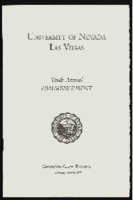Search the Special Collections and Archives Portal
Search Results
Delon Potter oral history interview
Identifier
Abstract
Oral history interview with Delon Potter conducted by Eleanor Christoffersen on February 3, 1972 for the Ralph Roske Oral History Project on Early Las Vegas. In this brief interview, Potter, a Mesquite, Nevada native, talks about his birth in 1909 and his move to Las Vegas in 1933. He describes the early town and some of the more notable inhabitants including "Pop" Squires, working at the Winterwood Ranch at the base of Sunrise Mountain, as a sheep herder near Kaolin, Nevada, and later as a construction worker at the Hoover Dam. After the war, Potter explains that he tried running his own ranch in Utah before moving back to Henderson, Nevada, working for U. S. Lime and trading horses throughout Nevada, Utah, and Arizona.
Archival Collection
Frank Gagliardi Music Manuscript Collection
Identifier
Abstract
The Frank Gagliardi Music Manuscript Collection (approximately 1964-1974) contains musical arrangements of standard Frank Sinatra songs, printed or photocopied with annotations. Each part is in its own folder, and each song is numbered. Frank Gagliardi performed as percussionist in Antonio Morelli's orchestra for the Sands Hotel in Las Vegas, Nevada, where he played for Frank Sinatra and other notable entertainers during the 1960s and 1970s.
Archival Collection
Kaweeda Adams oral history interview
Identifier
Abstract
Oral history interview with Kaweeda Adams conducted by Kim Kershaw on March 05, 2004 for the Public School Principalship Oral History Project. In this interview, Adams reflects upon her career as a teacher in Louisiana from the 1980s to the 1990s, and as a teacher and administrator with Nevada’s Clark County School District (CCSD) from the 1990s to the early 2000s. She discusses her upbringing, and how her upbringing influenced her pursuit of education. She describes the process by which she became a teacher and eventually administrator, and compares her experiences working in Louisiana and Nevada. She discusses how these experiences shaped her philosophy of education, as well as changes that she has observed in the students over time. She describes her regular job duties, as well as challenges that she faced as a school administrator such as teacher dismissal and evaluations.
Archival Collection
Q. B. Bush Papers
Identifier
Abstract
The Q. B. Bush Papers are comprised of Q. B. Bush's personal papers dating from 1957 to 2018 and document Bush's work in Westside Las Vegas, Nevada casinos including the Moulin Rouge, Town Tavern, and the El Morocco. The collection also documents Bush's involvement with the Dealers Security Association and the association's effort to provide better working conditions for African American casino employees. Included are both original photographs and copies of photographs that document the African American casinos where Bush worked, as well as the Bush family at various events.
Archival Collection
Nevada Watercolor Society Records
Identifier
Abstract
The Nevada Watercolor Society Records (1969-2009) contain watercolor paintings and organizational records pertaining to the Nevada Watercolor Society, a non-profit organization that aims to promote watermedia painting and art appreciation. Organizational records contain materials including by-laws, articles of incorporation, newsletters, exhibit information, tax and financial records, receipts, photographs, negatives, and newspaper clippings. The collection also includes paintings by society members and newspaper clippings about art exhibitions and artists in Las Vegas, Nevada.
Archival Collection
Las Vegas Rotary Club Records
Identifier
Abstract
The Las Vegas Rotary Club Records (1981-2022) contain award certificates, club directories and rosters, Las Vegas Rotary publications, commemorative material including a 20-foot by 34-foot velvet curtain. The collection also contains plastic and metal Rotary Club signs from across the United States and international locations, material from a Rotary Club in Africa, and a digital video segment made in 2013 about the history of the Las Vegas Rotary.
Archival Collection
Joan Olson Griffith oral history interview
Identifier
Abstract
Oral history interview with Joan Olson Griffith conducted by Sharee Schrader on April 12, 2005 for the History of Blue Diamond Village in Nevada Oral History Project. Griffith begins by discussing why she moved to Blue Diamond, Nevada with her family due to job opportunities at the Blue Diamond Plant, where they manufactured wallboard, in 1956. She describes life in Blue Diamond and rural Nevada, the education available in the village, and Blue Diamond's proximity to Bonnie Springs Ranch and structures made for the filming of Western themed media. Griffith concludes by discussing how Blue Diamond has changed since the 1950s and being a Sunday school teacher for eighteen years.
Archival Collection
John West oral history interview
Identifier
Abstract
Oral history interview with John West conducted by Claytee D. White on August 10, 2000 for the Boyer Early Las Vegas Oral History Project. In this interview, West discusses his family background and arriving to Las Vegas, Nevada in 1954. West describes his educational experiences in Las Vegas and his career as a clinical psychologist. He recalls his father’s career in medicine and becoming the first African American licensed medical doctor in Las Vegas. West then talks about attending entertainment events before race integration was introduced, and the voting patterns in West Las Vegas. Lastly, West discusses his father’s decision to remain living in West Las Vegas and operating his medical office there after integration.
Archival Collection
Richard D. Chase oral history interview
Identifier
Abstract
Oral history interview with Richard D. Chase conducted by Helen Rondthaler on October 17, 1972 for the Ralph Roske Oral History Project on Early Las Vegas. Chase discusses the history of Las Vegas, Nevada from 1945, touching on topics such as the housing shortage during the 1940s, The Red Rooster swingers’ club, Billy Moore, Sam Larson, Ira Goldring, atomic bomb testing, and the Nevada environment. Chase discusses the importance of construction-based labor to the development of Southern Nevada. Chase also explains at length the impact of the Nevada Test Site on his construction company.
Archival Collection

University of Nevada, Las Vegas (UNLV) 10th commencement program
Date
Archival Collection
Description
Commencement program from University of Nevada, Las Vegas Commencement Programs and Graduation Lists (UA-00115).
Text
